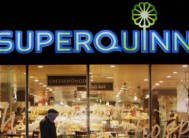Wednesday 12th February 2014
Enda Kenny claim Irish Income tax is too high


TAOISEACH HINTS AT RATE CUT IN BUDGET FOR 2015
Income tax here is too high and a cut could be on the way in the next Budget, it was revealed today.
The Taoiseach has conceded the amount of cash docked from worker’s wages is excessive.
Mr Kenny’s admission could herald the first tax cuts since the recession struck in 2008.
He said: “We recognise that income tax levels are too high here. This is a priority for government, but you can only deliver it if you can actually pay for it.
“All of this will be taken into account as we prepare for the Budget for 2015.” The Coalition, especially the Labour party, has been coming under increasing pressure to help struggling middle-income families.
The disclosure this week that US multi-nationals might be paying less than 3% corporation tax will turn up the heat to deliver tax cuts.
Mr Kenny was speaking before an address to Ibec’s Chief Executive Officers conference at the Convention Centre in Dublin.
The Taoiseach told the American CNBC cable channel that creating new jobs was his Government’s top priority. He said he was hopeful 50,000 positions will be created this year and in 2015.
Ibec chief Danny McCoy called for the tax-cutting agenda to be fast-tracked.
He said: “Up to half the companies expect that they will be paying pay increases in 2014, but half still need wage freezes.
“We can’t have across-the-board wage demands, but we can certainly get disposable income increased by reducing those taxes.”
“At 52% we now have one of the highest marginal tax rates in the OECD, well above the average of 36%.”
Younger Irish children presenting with anorexia “Now more boys”


Children are presenting to hospital with anorexia nervosa at an earlier age and the condition is affecting an increasing number of boys, a new Irish study has found.
According to researchers, anorexia is a serious mental health illness that is best treated in the community. However if a person’s weight reaches a critically low level, they will require hospitalisation.
The 2002 Census estimated that some 2,400 teenage girls were affected. The average age of onset among them was 14. However other than this, there is very little published Irish data on the condition, so the researchers decided to investigate further.
They looked at all inpatients admitted to Temple Street Children’s Hospital with anorexia between 2005 and 2011.
They found that the average age of onset of the condition was 13.5 years, six months younger than the 2002 figures – this indicates that anorexia is presenting at an earlier age.
All of the patients came into hospital via the emergency department (ED). Almost two in three were self-referred, while the rest were referred by a GP.
Boys accounted for almost one in three admissions. However on admission, girls were found to be more underweight than boys even though they tended to present to hospital sooner than boys.
The most common features of the illness after low weight were over-exercising and food restriction. One in four patients were also known to have been vomiting. All of the girls who had reached puberty had amenorrhea (an absence of menstrual periods).
Overall, the hospital noted a big increase in the number of children presenting with anorexia over the last 10 years and this mirrors UK figures.
The high number of boys presenting is also in line with recent research which indicates a higher prevalence among males.
The fact that girls tend to present to hospital sooner suggests that there is better awareness and detection in girls.
The researchers expressed concern that ‘the overall mean age of onset was estimated at six months prior to seeking treatment’. They pointed out that the longer it takes to get treated, the worse the prognosis.
Early detection and treatment within the community is more preferable to hospitalisation later, they said.
Meanwhile, the study also noted that the average length of stay in hospital is over five weeks. This is expensive and requires many resources, such as specialist staff training.
The researchers added that the increase in children presenting with anorexia has important implications for community and hospital services. They emphasised that the new national children’s hospital, which is to be built on the grounds of St James’s Hospital in Dublin, will require dedicated beds and specialist staff to deal with this serious issue.
Superquinn stores to be renamed SuperValu by Musgrave’s
Musgraves are to merge 24 Superquinn shops with SuperValu from tomorrow.
It has been in business for 54 years, but the Superquinn brand will be checking out of the Irish grocery market for good tomorrow.
Cork wholesale group Musgrave, which acquired the business for €229 million in October 2011, has decided to ditch the Superquinn name and rebrand its supermarkets under the SuperValu banner.
All 24 Superquinn stores will be renamed as SuperValu from tomorrow, consigning the Superquinn name to grocery chain heaven.
SuperValu managing director Martin Kelleher said the name change follows an “excellent performance” by SuperValu over the Christmas period when it was the top performing supermarket with its market share increasing to 20.1 per cent for the last 12 weeks of 2013.
“Since announcing our plans to rename Superquinn as SuperValu in August, the consumer response has been very positive demonstrating that both brands are better together,” he added.
The expanded SuperValu network will now consist of 223 stores with a turnover of €2.6 billion and 14,500 employees.
SuperValu is also currently implementing a €20 million in-store investment programme which will see the former Superquinn network upgraded with a new focus on service, range, quality and value. This is in addition to €10 million invested during 2013.
Retire your robots and free the poor people
The prospect of far better lives depends on how the gains are produced and distributed
In 1955, Walter Reuther, head of the US car workers’ union, told of a visit to a new automatically operated Ford plant.
Pointing to all the robots, his host asked: “How are you going to collect union dues from those guys?” Mr Reuther replied: “And how are you going to get them to buy Fords?” Automation is not new. Neither is the debate about its effects. How far, then, does what Erik Brynjolfsson and Andrew McAfee call The Second Machine Age alter the questions or the answers?
I laid out the core argument last week. I noted that the rise of information technology coincides with increasing income inequality. Lawrence Mishel of the Washington-based Economic Policy Institute challenges the notion that the former has been the principal cause of the latter.
Mishel notes: “Rising executive pay and the expansion of, and better pay in, the financial sector can account for two-thirds of increased incomes at the top.”
Changing social norms, the rise of stock-based remuneration and the extraordinary expansion of the financial sector also contributed. While it was a factor, technology has not determined economic outcomes.
Yet technology could become far more important. Brynjolfsson and McAfee also argue that it will make us more prosperous; and it will shift the distribution of opportunities among workers and between workers and owners of capital.
The economic impacts of new technologies are many and complex. They include: new services, such as Facebook; disintermediation of old systems of distribution via iTunes or Amazon; new products, such as smartphones; and new machines, such as robots. The latter awaken fears that intelligent machines will render a vast number of people redundant. A recent paper by Carl Frey and Michael Osborne of Oxford University concludes that 47 per cent of US jobs are at high risk from automation.
Computer capital
In the 19th century, they argue, machines replaced artisans and benefited unskilled labour. In the 20th century, computers replaced middle-income jobs, creating a polarised labour market. Over the next decades, however, “most workers in transport and logistics occupations, together with the bulk of office and administrative support workers, and labour in production occupations, are likely to be substituted by computer capital”.
Moreover, “computerisation will mainly substitute for low-skill and low-wage jobs in the near future. By contrast, high-skill and high-wage occupations are the least susceptible to computer capital.” This, then, would exacerbate inequality.
Jeffrey Sachs of Columbia University and Laurence Kotlikoff of Boston University even argue that the rise in productivity might make future generations worse off in aggregate.
The replacement of workers by robots could shift income from the former to the robots’ owners, most of whom will be retired and are assumed to save less than the young. This would lower investment in human capital because the young could no longer afford to pay for it; and in machines because savings in this economy would fall.
The argument that a rise in potential productivity would make us permanently worse off is ingenious. More plausible, to me at least, are other possibilities: there could be a large adjustment shock as workers are laid off; the market wages of unskilled people might fall far below a socially acceptable minimum; and, combined with other new technologies, robots might make the distribution of income far more unequal than it is already.
Is water flowing on the red planet Mars? Maybe say scientists.
A NASA spacecraft orbiting Mars has spotted signs that water might be flowing just below the Red Planet’s surface.
New clues are emerging about the mysterious streaks that appear on Mars’ surface during warm weather, though scientists still can’t say for sure that they’re caused by flowing water.
The marks, known as recurring slope lineae (RSL), snake down some crater walls and other inclines when the mercury rises on the Red Planet. New research finds seasonal changes in iron minerals at RSL sites, suggesting that brines containing an iron antifreeze may flow there from time to time — but direct evidence of water remains elusive.
“We still don’t have a smoking gun for existence of water in RSL, although we’re not sure how this process would take place without water,” Lujendra Ojha, a graduate student at Georgia Tech in Atlanta, lead author of two recent RSL studies, said in a statement. (Ojha discovered the RSL in 2011, while an undergraduate at the University of Arizona.) [Photos: The Search for Water on Mars]
RECOMMENDED: Are you scientifically literate? Take our quiz
Ojha and his colleagues studied images of 13 RSL sites taken by the Compact Reconnaissance Imaging Spectrometer for Mars (CRISM), an instrument aboard NASA’s Mars Reconnaissance Orbiter (MRO). They saw relatively high concentrations of iron minerals at most of the sites.
“Just like the RSL themselves, the strength of the spectral signatures varies according to the seasons,” Ojha said. “They’re stronger when it’s warmer and less significant when it’s colder.”
Many scientists think the recurring slope lineae are created by water flowing just beneath the Martian surface. This water — which would leave the iron antifreezes and other minerals in its wake — likely contains salts that lower its freezing point significantly, allowing it to stay liquid despite frigid Red Planet temperatures.
While the researchers didn’t see any spectral signatures of water in the CRISM images, that doesn’t rule out the substance’s presence at RSL sites, scientists said.
For example, the observations were made exclusively in the afternoon and thus could have missed surface water appearing in the morning. Further, each CRISM image observed a large area, possibly making it tough to spot signs of water in the narrow RSL streaks.
The researchers reported these results late last year in the journal Geophysical Research Letters. In another study, due out next month in the journal Icarus, a team led by Ojha analyzed pictures snapped by MRO and NASA’s Mars Odyssey orbiter, looking for patterns in RSL formation on the Red Planet.
The team found 200 locations where conditions seemed ideal for seasonal streaks — areas in the southern mid-latitudes with rocky cliffs — but found only 13 with actual RSL marks.
“The fact that RSL occur in a few sites and not others indicates additional unknown factors such as availability of water or salts may play a crucial role in RSL formation,” Ojha said.





No comments:
Post a Comment